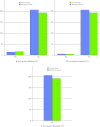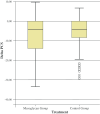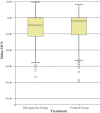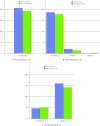Mesoglycan for pain control after open excisional HAEMOrrhoidectomy (MeHAEMO): an observational multicentre study on behalf of the Italian Society of Colorectal Surgery (SICCR)
- PMID: 33092570
- PMCID: PMC7583301
- DOI: 10.1186/s12893-020-00914-5
Mesoglycan for pain control after open excisional HAEMOrrhoidectomy (MeHAEMO): an observational multicentre study on behalf of the Italian Society of Colorectal Surgery (SICCR)
Erratum in
-
Correction to: Mesoglycan for pain control after open excisional HAEMOrrhoidectomy (MeHAEMO): an observational multicentre study on behalf of the Italian Society of Colorectal Surgery (SICCR).BMC Surg. 2020 Nov 11;20(1):277. doi: 10.1186/s12893-020-00940-3. BMC Surg. 2020. PMID: 33176768 Free PMC article.
Abstract
Background: Excisional haemorrhoidectomy is the gold standard technique in patients with III and IV degree haemorrhoidal disease (HD). However, it is associated with a significant rate of post-operative pain. The aim of our study was to evaluate the efficacy of mesoglycan in the post-operative period of patients who underwent open excisional diathermy haemorrhoidectomy (OEH).
Methods: This was a retrospective multicentre observational study. Three hundred ninety-eight patients from sixteen colorectal referral centres who underwent OEH for III and IV HD were enrolled. All patients were followed-up on the first post-operative day (T1) and after 1 week (T2), 3 weeks (T3) and 6 weeks (T4). BMI, habits, SF-12 questionnaire, VAS at rest (VASs), after defecation (VASd), and after anorectal digital examination (VASe), bleeding and thrombosis, time to surgical wound healing and autonomy were evaluated.
Results: In the mesoglycan group, post-operative thrombosis was significantly reduced at T2 (p < 0.05) and T3 (p < 0.005), and all patients experienced less post-operative pain at each time point (p < 0.001 except for VASe T4 p = 0.003). There were no significant differences between the two groups regarding the time to surgical wound healing or post-operative bleeding. There was an early recovery of autonomy in the mesoglycan group in all three follow-up periods (T2 p = 0.016; T3 p = 0.002; T4 p = 0.007).
Conclusions: The use of mesoglycan led to a significant reduction in post-operative thrombosis and pain with consequent early resumption of autonomy. Trial registration NCT04481698-Mesoglycan for Pain Control After Open Excisional HAEMOrrhoidectomy (MeHAEMO) https://clinicaltrials.gov/ct2/show/NCT04481698?term=Mesoglycan+for+Pain+Control+After+Open+Excisional+HAEMOrrhoidectomy+%28MeHAEMO%29&draw=2&rank=1.
Keywords: Haemorrhoidal disease; Mesoglycan; Mucocutaneous bridges; Open excisional haemorrhoidectomy; Post-operative pain; Thrombosis.
Conflict of interest statement
The Authors declare that they have no competing interests. The Authors alone are responsible for the content and writing of the paper.
Figures
References
-
- Gallo G, Sacco R, Sammarco G. Epidemiology of hemorrhoidal disease. In: Ratto C, Parello A, Litta F, editors. Hemorrhoids coloproctology. Cham: Springer; 2018. pp. 3–7.
-
- Ratto C, Campennì P, Papeo F, Donisi L, Litta F, Parello A. Transanal hemorrhoidal dearterialization (THD) for hemorrhoidal disease: a single-center study on 1000 consecutive cases and a review of the literature. Tech Coloproctol. 2017;21:953–962. doi: 10.1007/s10151-017-1726-5. - DOI - PMC - PubMed
Publication types
MeSH terms
Substances
LinkOut - more resources
Full Text Sources
Medical






